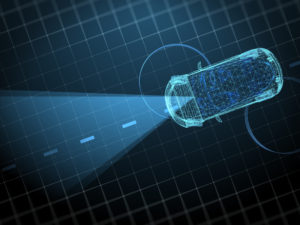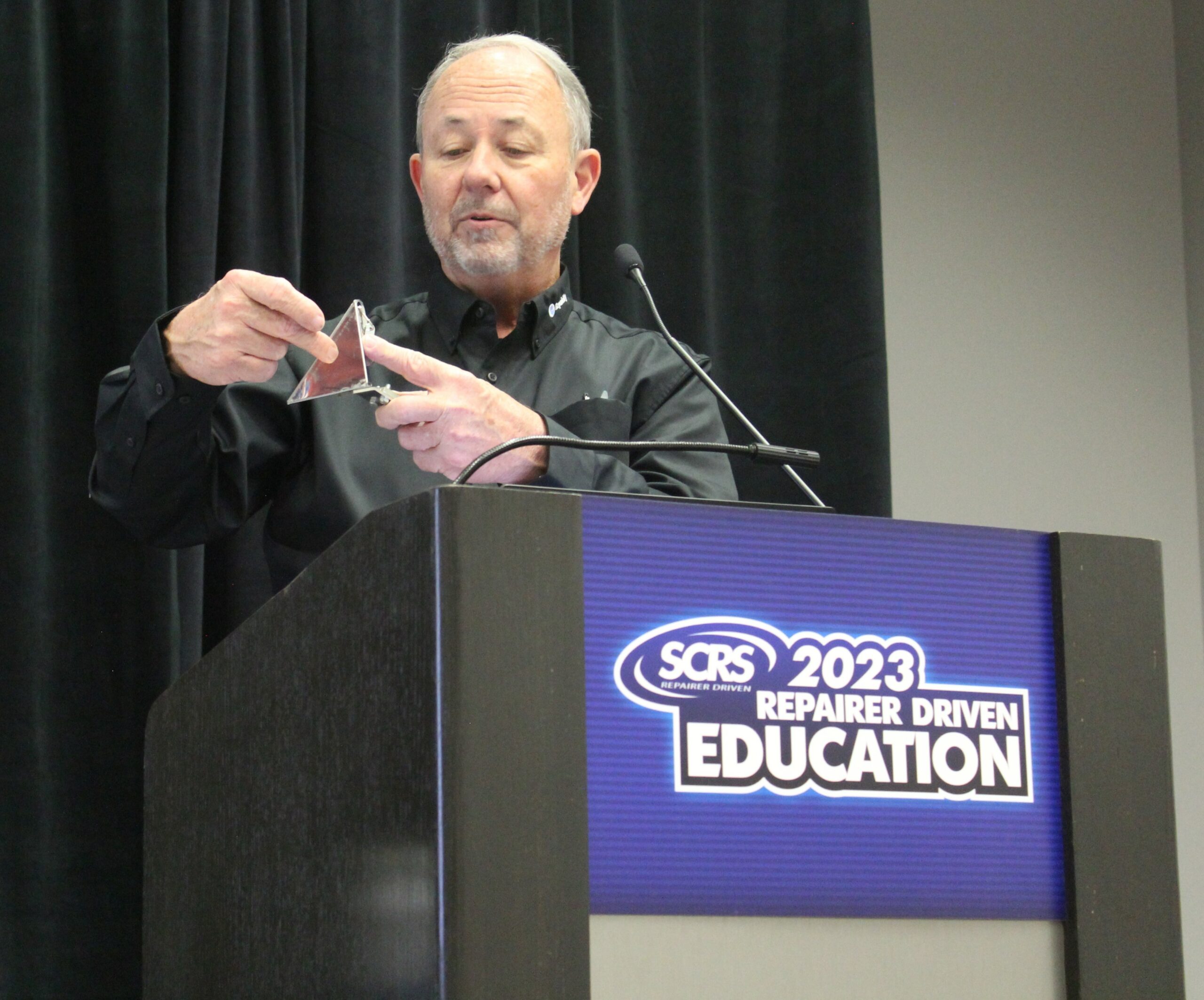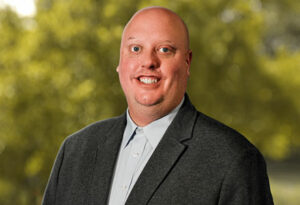
Repairer Driven Education: OEM procedures & scan tool types important factors of ADAS calibrations
By onEducation | Repair Operations
When it comes to advanced driver assistance system (ADAS) calibrations, one of the most important things for repairers to know is that their chosen scan tool returns accurate information in line with OEM repair procedures, in addition to using the most accurate targets and placing them correctly, according to Repairify Training and Organizational Development Vice President Chris Chesney.
During a 90-minute Society of Collision Repair Specialists (SCRS) Repairer Driven Education (RDE) session last week, Chesney shared some of the do’s and don’ts in picking out a diagnostic scan tool. He also provided an overview of asTech’s Rules Engine research findings. It was one of 22 RDE sessions held during SEMA Week in Las Vegas.
“We’re not trying to be the Gestapo and say, ‘Thou shalt only use this scan tool to scan,'” Chesney said. “That’s your business decision. “We’re just trying to provide you the insights and the way we do that is through our Rules Engine. Rules Engine applies that data set with your rules [and] your priorities of the rules.”
For example, a Honda-certified repair center could set the rule that all Hondas from a certain model year forward must be scanned using an OEM scan tool. And for older vehicles that don’t require an OEM scan, a rule could be added that says a local scan will be used such as rules by the carrier or the repair center’s own rules, he added.
“All of this technology that we’re dealing with is based on science, physics, [and] chemistry so the backend of everything that the OEM prescribes is the same thing that we’re looking at,” Chesney said. “We’ve gathered thousands and thousands of data points, not [just on] one vehicle, and found something that we think is normal.”
Millions of dollars have been spent so far on continuing performance testing of aftermarket scan tools compared to OEM scan tools. asTech has completed test scans on hundreds of thousands of vehicles — varying in make, model, and trim level — from model years 2014-2023.
During testing for the Rules Engine, technicians plug in OEM and aftermarket tools at the same time on the same type of vehicle and then put the data into a database that compares the reports.
Every time an OEM or aftermarket scan tool software is updated, another test is conducted, often daily, Chesney said, but he noted that automaker scan tools aren’t always up-to-date.
In a conversation with Repairer Driven News, Repairify Global Holdings President Cris Hollingsworth added, “We run the same test again and again as the aftermarket tool providers put out their updates. We will adjust the Rules Engine as aftermarket providers update their data sets so it is a living breathing rule set… it’s not a static data set because it could go out of date if we left it as a static data set.”
When asked how repairers would know if aftermarket scan tools haven’t been updated, therefore not updating the Rules Engine, Hollingsworth replied, “They don’t have to worry about updating their own tools because our tools are updated every single night in our technology centers. Effectively, they are using our tools that sit in our technology deck so they’re always working with a tool that is updated.”
The purpose of the Rules Engine is to get repair centers and the carriers they work with on the same page about scans and calibrations, Hollingsworth said. “What the Rules Engine does is it creates this consensus place where everyone can align on what has created a lot of friction in the industry today… do I pay you for this? Do I not pay for that? …[it’s] a place in which the shop and the carrier can align on what is considered a qualified service or qualified scan.”
Scan results from 17,500 vehicles representing 3,000 year, make, model, and trim combinations by asTech coupled with millions of pre- and post-scans and calibrations conducted by asTech customers have been added to the Rules Engine database so far. Diagnostic trouble codes (DTCs) that have occurred are included as well.
“We’re not trying to shortcut the calibration process or consolidate DTCs in a tool,” he said. “Understand what it [vehicle] contains before you start repairing the vehicle and making sure that the systems operate when you send it back to the customer is as old as the scan tool itself… Completeness and accuracy is the real key.
“Some of them work but not on every year, make, model, trim; not on every module, not on every DTC, and not on every PID [performance information data]… No said DTC is a failure of a test on a component’s circuit or system.”
Chesney compared DTCs to a zip code, noting that they give repairers direction on where to look when researching for a repair. However, he cautioned that DTCs don’t occur when it comes to damaged or altered functioning ADAS.
A missing calibration could be found though. “It knows what’s supposed to be there and when you do an all-module scan, it will come back and say it’s missing or it could be just inactive,” Chesney said.
The issue could be as simple as forgetting to connect a replaced component, such as a blind spot radar, he added.
He compared each scan tool’s interpretation of the questions they’re asked to differing language dialects, i.e., the tool could misinterpret or not recognize the information based on the question.
Chesney emphasized that repairers need to look up OEM service and repair procedure information for every ADAS calibration because they’re updated often, as quickly as within hours of each other.
“They’ll put in their instructions of where to place their target, defining the distance from the center line or the front of that sensor,” he said. “You do the plumb bob drop, make the mark on the floor — the distance from that point to maybe the front edge of their stand. That may not be the same as the tip of the trihedral.”
When picking a calibration target, Chesney said research compiled through Rules Engine has found that a trihedral is the most accurate while the brand doesn’t matter as much.
“The goal of our organization, right now from a calibration perspective, is to try to get in a position where we’re target agnostic,” he said. “The reason we want to do that is because many of you have already made target investments and you may have made good investments. You may have made investments that have decent targets and they’re OE-compatible or OE-type targets; they’re essentially the same and they work but the directions and placement or the technology in running the calibration through the scan tool isn’t what you need — it’s not up-to-date, it doesn’t follow the process, whatever the case may be.
“I don’t want to argue about, ‘What’s the right way to calibrate that?’ That’s important but the important thing is that we’re scanning and we’re starting to get there.”
He added that the top priority is the safety of the motorists because ADAS work if they’re calibrated right. “They need to be put in a ready-to-crash state.”
“We’re dealing with safety systems — it’s not just all about radar, sonar, and cameras, et cetera,” Chesney said. “It’s still about stopping the doggone car when I put my foot on the brake and trying to maintain steering controls while I’m skidding to a stop trying to avoid an accident. That’s the first part of ADAS — ABS.
“If the OEM tool displays it and the aftermarket doesn’t, it doesn’t count. It’s not the same… this kind of breaks the idea that for the first two years of the life of a vehicle, the OEM [scan tool] is going to be required and the aftermarket [scan tool] is going to take time to catch up.”
Chesney said, based on asTech’s research, that he doesn’t go along with the notion some repairers have that up-to-date aftermarket tools don’t matter as much to the collision industry.
“It [vehicle] could’ve just come off the showroom floor and… they stepped on the gas and they like that so they did it again and now it’s in the shop,” he said. “You’ve got to be able to communicate with that car.”
asTech has the beginnings of a catalog of every target in the industry, compared to OEM targets, not just from size, look, shape, and color but color analysis and color contrast analysis, according to Chesney.
It’s also important for repairers to know that in metallic paint, the metal flakes are electromagnetically charged during manufacturing so that they lay flat and don’t affect calibrations. After a collision, when they’re brought to repair centers, that’s not the case. Paint suppliers, however, can offer solutions.
“They can help you make sure that you’re applying the product correctly and when you should not repair a bumper cover that’s got damage in the radar area,” Chesney said. “Unfortunately, they put the sensor in the spot that gets damaged the most, in the corner of the bumper cover.”
OEMs typically use trihedral targets because they’re forgiving in alignment to the center, he added.
“Height, we want to be as accurate as possible; angle, we want to be facing you as much as possible,” Chesney said. “At the end of the day, if I’m not facing you square and I’m facing off maybe a degree, maybe half a degree, you shoot your signal to me and the target is big enough [that] it’s going to shoot back to you and you’ll receive it. That’s what the trihedral does… it’s the tip of the triangle that’s important and distance on these things is really important right now. It’s going to be hypercritical when imaging radar hits.”
Repairers should also be mindful of objects in the area of where the calibrations are taking place, including the stand that the target is on. It’s best to go with wood, plastic, carbon fiber, or PVC because metal can cause a reflection, impacting the accuracy of the calibrations.
Conditions are important as well; not only appropriate lighting, a level floor, and neutral-colored walls. Doors should be closed and fans turned off to avoid wind moving the target, no one should enter the adjustment because they could cause reflections, off a belt for example. The vehicle shouldn’t be moved or shaken, including getting in and out of it. Also, don’t turn off the ignition switch.
“The conditions are incredibly important, which means mobile [calibration] is risky at best,” Chesney said. “It’s hard to do. Mobile’s fine as long as you’re pulling everything inside and doing it in a controlled environment.”
A whole different animal in calibrations is modded vehicles such as those with larger tires and/or lift kits, which could cause ADAS to not operate correctly, which Chesney cautioned repairers to be mindful of.
In response to little information provided by OEMs on proper aftermarket calibrations on modified vehicles, SEMA has been researching how the safety and functionality of aftermarket-equipped vehicles with factory ADAS could be affected by a newly proposed National Highway Traffic Safety Administration (NHTSA) standard that would require automatic emergency braking (AEB) and pedestrian AEB systems on light vehicles.
“Several OEMs are already selling lifted trucks from the factory or authorized OE (dealership) modifications,” Mike Muller, SEMA aftermarket ADAS engineer, previously told Repairer Driven News. “The assumption is that they know what those limits are; however, in some of the vehicle instruction manuals to the consumers, it’s stated that you shouldn’t modify your vehicle. That’s where the question comes in. These authorized OE modifications are clearly there, so there needs to be allowances for the aftermarket to do the same.”
Repairify’s Jon Delgado led the engineering of the Rules Engine and, was awarded this year with SEMA’s Gen-III Innovator of the Year. The award honors an entrepreneurial individual age 40 or younger who is “creating new innovative breakthroughs within the areas of automotive aftermarket opportunities, advancement, best business practices, technology, or trends.”
Delgado was instrumental in delivering aftermarket scan tool testing data to the industry through a comprehensive API solution, merging asTech’s traditional remote OEM service offerings with comprehensive aftermarket alternatives known to be viable to the repair process, SEMA said in a news release.
Delgado also was part of creating asTech Insights, which uses an artificial intelligence system that takes the results from OEM-compatible scans to instantly generate custom collision repair recommendations specific to the vehicle and DTC codes. The model was trained on more than 210 million diagnosed trouble codes, SEMA said. Delgado has been a key contributor and leader in ADAS calibration identifications with his adasThink solution as well.
“We were very excited and very proud of Mr. Delgado and the award that he won,” Hollingsworth said. “We couldn’t be more excited for the recognition of what his team has done… the way that we operate when we have these types of innovations with these types of new products, it takes a proverbial village.”
Images
Featured stock image credit: Just_Super/iStock
Repairify’s Chris Chesney speaks during a 2023 SCRS Repairer Driven Education session. (Lurah Lowery/Repairer Driven News)
Jon Delgado photo courtesy of SEMA


